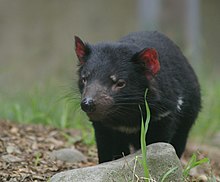

| Dasyurids[1] | |
|---|---|

| |
| Tasmanian devil | |
| Scientific classification | |
| Domain: | Eukaryota |
| Kingdom: | Animalia |
| Phylum: | Chordata |
| Class: | Mammalia |
| Infraclass: | Marsupialia |
| Order: | Dasyuromorphia |
| Family: | Dasyuridae Goldfuss, 1820 |
| Type genus | |
| Dasyurus Geoffroy, 1796 | |
| Subfamilies & tribes | |
The Dasyuridae are a family of marsupials native to Australia and New Guinea, including 71 extant species divided into 17 genera. Many are small and mouse-like or shrew-like, giving some of them the name marsupial miceormarsupial shrews, but the group also includes the cat-sized quolls, as well as the Tasmanian devil. They are found in a wide range of habitats, including grassland, underground, forests, and mountains, and some species are arboreal or semiaquatic. The Dasyuridae are often called the 'marsupial carnivores', as most members of the family are insectivores.
Most dasyurids are roughly the size of mice, but a few species are much larger. The smallest species is the Pilbara ningaui, which is from 4.6 to 5.7 cm (1.8 to 2.2 in) in length, and weighs just 2 to 9 g (0.07 to 0.3 oz), while the largest, the Tasmanian devil, is 57 to 65 cm (22 to 26 in) long, and weighs from 6 to 8 kg (13 to 18 lb). The smaller dasyurids typically resemble shrews or mice in appearance, with long tails and narrow, pointed noses. The larger species bear a resemblance to such placental carnivores as mongoosesormustelids.[2]
Many features of dasyurids are considered primitive; that is, they resemble the features of the earliest marsupials, from which other species, such as kangaroos and bandicoots, later diverged. For example, all of the toes in dasyurids are separate, whereas in many other marsupials, the second and third toes are fused. Similarly, many species lack a full marsupial pouch, instead having a simple fold of skin surrounding the teats to provide some protection to the developing young. The dentition of dasyurids is also considered primitive, and differs from that of other marsupials, with a dental formula of: 4.1.2-3.43.1.2-3.4. Their dentition is similar to many carnivores, characterized by bladelike incisors, large, sharp canines, and upper molars modified with large, sharp cusps.[3]
Dasyurids are primarily insectivorous, but they will also eat small lizards, fruit, and flowers. One of the few exceptions to this rule is the Tasmanian devil, which subsists mainly on vertebrate carrion.[2] They have relatively simple digestive tracts, as is typical of insectivores and other carnivores.
Gestation lasts from 12–16 days, and results in the birth of from two to 12 young, depending on species. Smaller species typically breed at least twice a year, while the larger forms tend to breed just once. The length of lactation reflects this, with young dunnarts, for example, being weaned after 60–70 days, but young quolls only after 8–9 months. Most dasyurid species are sexually mature at one year of age, but, again, the quolls and Tasmanian devil, being larger, take longer to mature and do not reach full adulthood for about two years.[2]
Adult dasyurids are typically solitary, or travel in small groups of two to three individuals.


The listing for extant species is based on The Third edition of Wilson & Reeder's Mammal Species of the World (2005), except where the Mammal Diversity Database and IUCN agree on a change.
| Dasyuridae |
|
|---|---|
| Authority control databases: National |
|
|---|